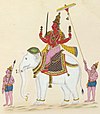វាហណ

វាហណ ( សំស្ក្រឹត: वाहन ) ឬ វាហនម ( សំស្ក្រឹត: वाहनम् ) តំណាងឱ្យសត្វ ជាទូទៅសត្វ ឬវត្ថុទេវកថា អាទិទេព ហិណ្ឌូ ជាក់លាក់មួយត្រូវបានគេនិយាយថាប្រើជាយានជំនិះ។ ក្នុងសមត្ថភាពនេះ វចនានុក្រមនេះត្រូវបានគេហៅជាញឹកញាប់ថា «ភ្នំ» របស់អាទិទេព។ ដោយភាពជាដៃគូរវាងអាទិទេព និង វាហណ របស់គាត់ត្រូវបានត្បាញអំពី រូបចម្លាក់ និង ទ្រឹស្ដីហិណ្ឌូ ជាច្រើន។ អាទិទេពត្រូវបានគេពណ៌នាជាញឹកញាប់ថាកំពុងជិះ (ឬគ្រាន់តែឡើងលើ)វាហណ។ ពេលផ្សេងទៀតវាហណត្រូវបានបង្ហាញនៅខាងអាទិទេព ឬតំណាងជានិមិត្តរូបថាជាគុណលក្ខណៈទេវៈ។ វាហណអាចចាត់ទុកថាជា គ្រឿងបរិក្ខារ នៃអាទិទេព៖ ទោះបីជា វាហណអាចធ្វើសកម្មភាពដោយឯករាជ្យក៏ដោយ ក៏វានៅតែជានិមិត្តសញ្ញាមុខងារ ឬសូម្បីតែ វាក្យសម្ព័ន្ធ នៃ "អ្នកជិះ" របស់ពួកគេ។ អាទិទេពអាចត្រូវបានគេឃើញអង្គុយ ឬឈរលើវាហណ។ ពួកគេអាចអង្គុយនៅលើវេទិកាតូចមួយ ឬជិះលើកែប ឬខ្នងទទេ។ [១]
និរុត្តិសាស្ត្រ
[កែប្រែ]វះ ជា ភាសាសំស្ក្រឹត មានន័យថា ដឹក ឬដឹកជញ្ជូន។ ពាក្យនេះក៏មានន័យថា ' យាន ' ជាភាសាសំស្ក្រឹត និង ភាសាឥណ្ឌា ផ្សេងទៀត [២] [៣]
និមិត្តសញ្ញា
[កែប្រែ]ឧទាហរណ៍
[កែប្រែ]គរុឌ
[កែប្រែ]គ្រុឌ និងរឿងរបស់គាត់នៃការក្លាយជាភ្នំនៃ ព្រះវិស្ណុ ត្រូវបានរៀបរាប់យ៉ាងបរិបូរណ៍នៅក្នុងអត្ថបទហិណ្ឌូ។ កើតនៅក្នុង វិនត និងទទួលបានអំណាចនៃ penance របស់ Kashyapa, demigod មានការសោកសៅនៅពេលដែលបានរកឃើញថាម្តាយរបស់គាត់ត្រូវបានធ្វើជាទាសករដោយ កទ្រុ ដ៏ឃោរឃៅ។ នៅពេលដែលគាត់បានអង្វរ កទ្រុ ឱ្យដោះលែងម្តាយរបស់គាត់ ក្រោយមកទៀតបានទាមទារទឹកដមនៃអមតៈជាតម្លៃនៃសេរីភាពរបស់នាង។ រឿងព្រេងរបស់ព្រះអង្គនៃការធានា អម្រឹត ជាទឹកដមនៃភាពអមតៈត្រូវបានពិពណ៌នាក្នុងវគ្គដែលគេស្គាល់ថាជា Amṛtakalaśāpaharaṇam [៤] :
Garuḍa approached the pot of nectar, and Viśvakarmā who attacked him first was felled to the ground. The dust storm raised by the waving of Garuḍa’s wings blinded everybody. The Devas and Indra, nay, even the sun and the Moon lined up against Garuḍa, but he defeated them all, and entered the particular place where the pot of nectar was kept. Two terrific wheels were rotating round the pot and they would cut into mince-meat anybody who tried to lay hands on the pot and a machine circled the wheels. Below the wheels were two monstrous serpents with glowing eyes and protruding tongues like flashes of fire, and the serpents never closed their eyes. The very look with those eyes was enough to poison anyone to death. Garuḍa blinded those eyes by raising a torrent of dust, pierced them in the middle with his beak and through the hole, his body reduced to such a tiny shape, went nearer to the pot. He destroyed the wheels and the machine, and carrying the pot of nectar in his beaks rose to the sky shielding the light of the sun by his outspread wings. Mahāviṣṇu, who became so much pleased with the tremendous achievements of Garuḍa asked him to choose any boon. Garuḍa requested Viṣṇu that he should be made his (Viṣṇu's) vehicle and rendered immortal without his tasting amṛta. Both the boons were granted.
មុសិក
[កែប្រែ]ខណៈពេលដែលព្រះ គនេស នៅក្មេង កណ្ដុរយក្សមួយក្បាលបានចាប់ផ្តើមធ្វើ ឱ្យមិត្តទាំងអស់របស់គាត់ភ័យខ្លាច។ គណេស បានចាប់គាត់ដោយ ឡាសោ របស់គាត់និងធ្វើឱ្យគាត់ឡើងភ្នំ។ មុសិក ដើមឡើយជា គន្ធវ៌ ឬតន្ត្រីករសេឡេស្ទាល។ បន្ទាប់ពីវង្វេងស្មារតីដើរលើជើងរបស់ Rishi (ឥសី) ឈ្មោះ វមទេវ, មុសិក ត្រូវបានបណ្តាសាហើយប្រែទៅជាកណ្តុរ។ ទោះជាយ៉ាងណាក៏ដោយ បន្ទាប់ពី ឥសី បានធូរស្បើយពីកំហឹងរបស់គាត់ គាត់បានសន្យាជាមួយ មុសិក ថានៅថ្ងៃណាមួយ ព្រះនឹងក្រាបនៅចំពោះមុខគាត់។ ទំនាយត្រូវបានសម្រេចនៅពេលដែលកណ្ដុរបានក្លាយជាវាហណរបស់ គណេស ។
នន្ទិ
[កែប្រែ]មុនពេលក្លាយជាយានជំនិះរបស់ព្រះសិវៈ នន្ទិ គឺជាអាទិទេពមួយអង្គដែលមានឈ្មោះថា នន្ទកេស្វរ ដែលជាម្ចាស់នៃសេចក្តីអំណរ និងជាម្ចាស់នៃតន្ត្រី និងរបាំ។ បន្ទាប់មកដោយគ្មានការព្រមាន ឈ្មោះនិងមុខងាររបស់គាត់ត្រូវបានផ្ទេរទៅទិដ្ឋភាពនៃព្រះសិវៈដែលគេស្គាល់ថាជាអាទិទេព នតរាជ ។ ពីពាក់កណ្តាលបុរស ពាក់កណ្តាលគោ គាត់បានក្លាយជាគោ។ តាំងពីពេលនោះមក គាត់បានមើលថែប្រាសាទនីមួយៗរបស់ព្រះសិវៈ ដោយតែងតែសម្លឹងមករកព្រះអង្គ។
បរវណិ
[កែប្រែ]កត៌ិកេយ ដែលជាព្រះសង្គ្រាមដែលគេស្គាល់ថាជា មុរុគន នៅ ភាគខាងត្បូងប្រទេសឥណ្ឌា ត្រូវបានគេដាក់នៅលើសត្វក្ងោកមួយដែលមានឈ្មោះថា បរវណិ ។ សត្វក្ងោកនេះដើមឡើយជាបិសាចហៅថា សុរបទ្ម ចំណែកសត្វមាន់ត្រូវបានគេហៅថាទេវតា ក្រិចិ ។ បន្ទាប់ពីការបង្កហេតុ មុរុគន នៅក្នុងការប្រយុទ្ធ បិសាចបានប្រែចិត្តនៅពេលនោះ ជើងរបស់គាត់បានចុះមកលើគាត់។ គាត់បានយកទម្រង់ដើមឈើ ហើយចាប់ផ្ដើមអធិស្ឋាន ។ ដើមឈើនេះត្រូវបានកាត់ជាពីរ។ ចាប់ពីពាក់កណ្តាលមួយ មុរុគន បានទាញ សត្វមាន់ មួយដែលគាត់បានធ្វើនិមិត្តសញ្ញារបស់គាត់ហើយពីមួយទៀតគឺសត្វក្ងោកដែលគាត់បានឡើងភ្នំ។ នៅក្នុងកំណែមួយទៀត កថ៌ិកេយ បានកើតមកដើម្បីសំលាប់អារក្ស តារាកសុរ ។ ព្រះអង្គត្រូវបានព្រះ ក្រិត្តិក លើកឡើងហើយបានដឹកនាំទ័ពដ៏ទេវភាពនៅពេលដែលគាត់មានអាយុ៦ថ្ងៃ។ វាត្រូវបានគេនិយាយថាបន្ទាប់ពីយកឈ្នះ តារាកសុរ ព្រះបានអត់ទោសឱ្យគាត់ហើយបានផ្លាស់ប្តូរគាត់ទៅជាសត្វក្ងោកជិះរបស់គាត់។
| វាហណ | ទេព | រូប |
|---|---|---|
| កណ្ដុរ | Ganesha (pictured) Vinayaki Karni Mata[៥] |

|
| សេះ | កល្កិ, Revanta, Chandra, Surya (pictured), Khandoba, Ayyappan Ushas Mhalsa |

|
| គ្រុឌ (pictured) | Vishnu, Krishna, Rama, Vaishnavi | 
|
| នន្ទិ (pictured) | Shiva, Maheshvari, Ishana Ishvari |

|
| ពពែ | Agni (pictured), Mangala Svaha Dhavdi Mata |

|
| ក្ងោក | Kartikeya (pictured), Kaumari Saraswati |

|
| ឆ្កែ | Bhairava (pictured) Hadkai mata |

|
| ហង្ស (pictured) | Brahma[១] Brahmani, Saraswati, Gayatri, Vishvakarma | 
|
| មករ | Ganga (pictured), Varuna, Akhilandeshwari, Khodiyar Kaveri Tapati Various river goddesses |

|
| ខ្លា | Chandraghanta, Kushmanda, Durga, Rahu, Ayyappan (pictured) Vaishno Devi |

|
| តោ | Skandamata, Katyayani, Parvati (pictured), Budha, Chandika, Mariamman, Kamakhya, Narasimhi, Kaushiki, Jagaddhatri, Durga | 
|
| ដំរី | Indra (pictured), Lakshmi, Shachi, Brihaspati | 
|
| សេក | Meenakshi, Kama (pictured), Rati | 
|
| ឈ្លូស | Chandra, Vayu (pictured) | 
|
| ក្របីព្រៃ | Yama (pictured), Varahi, Dhandai Devi Chamunda[៦] |

|
| ឆ្មា | Shashthi (pictured) | 
|
| លា | Kalaratri, Shitala (pictured), Kali, Alakshmi | 
|
| ទីទុយ | Lakshmi (pictured)[១][៧] Chamunda Kāla |

|
| ត្មាត | កេតុ (pictured), Shani Alakshmi Nirṛti |

|
| ក្អែក | Shani, Dhumavati (pictured) Jyestha |

|
| អណ្ដើក | យមុន (pictured) | 
|
| មាន់ | Bahuchara Mata (pictured) | 
|
| គោ | ទត្តត្រេយ (pictured), សៃលបុត្រី, Mahagauri, ភូមិ Umiya Maa Gatrad maa |

|
| ពស់ | មនសា (pictured) naagbai mata Nageswari mata |

|
| សាកសព (Betāl) | ចមុន្ទ (pictured), ស្មាសនកាលី | 
|
| ស្ការ | កុពេរ (pictured) ភទ្រា |

|
| មនុស្សប្រុស | និឫតិ (pictured), កុពេរ, ភទ្រទេវី | 
|
| ទា | មនសា (pictured) |

|
| ត្រីIlish | ឈុលេលាល |

|
| អូដ្ឋ | ហនុមាន, មោម៉ៃ[៨] | |
| ចចក | សិវតុតិ, កាលី | |
| ឆែព្រៃ | ព្រះម៉ែចាមុណទា[៩] | |
| ពពែ | Meldi Mata[១០][១១] and Gel maa | |
| ខ្ទីង | Paplaj Mata Verai Maa |
- ↑ ១,០ ១,១ ១,២ Glossary: Vahana Archived 2009-02-05 at the វេយប៊ែខ ម៉ាស៊ីន.. Undated. Accessed August 10, 2007. Cite error: Invalid
<ref>tag; name "GLOSSARY" defined multiple times with different content - ↑ www.wisdomlib.org (2021-08-12). "Animals as vehicles of Gods [Chapter 2.7]". www.wisdomlib.org (in អង់គ្លេស). Archived from the original on 2022-08-11. Retrieved 2022-08-11.
- ↑ "vahana meaning in English | vahana translation in English". SHABDKOSH.
- ↑ www.wisdomlib.org (2019-01-28). "Story of Garuḍa". www.wisdomlib.org (in អង់គ្លេស). Archived from the original on 2022-08-11. Retrieved 2022-08-11.
- ↑ "Folk Deity: Lok Devta & Devis of Rajasthan". Archived from the original on 2022-07-13. Retrieved 2022-07-13.
- ↑ "Goddess Chamundi". Archived from the original on 2022-07-12. Retrieved 2022-07-12.
- ↑ Hindu Devotion: Lakshmi Archived 2007-09-26 at the វេយប៊ែខ ម៉ាស៊ីន.. Accessed August 10, 2007.
- ↑ "19. Mithapur,Shivarjpur, Nageshwar". 31 August 2016. Archived from the original on 13 July 2022. Retrieved 13 July 2022.
- ↑ "Sapta Matrika | 7 Matara - Seven Forms of Goddess Shakti". Archived from the original on 2022-07-12. Retrieved 2022-07-12.
- ↑ "Gods outside temples". Mumbai Mirror (in អង់គ្លេស). Retrieved 2022-10-11.
- ↑ (ជាen) Gods of Heaven, Home of Gods: A Study of Popular Prints. 1994. ល.ស.ប.អ. 978-81-85683-05-8. https://books.google.com/books?id=-kzsAAAAIAAJ&q=meldi+mata.
